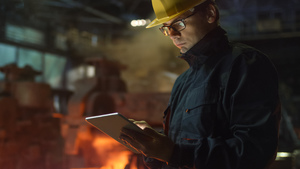

|
Edward Lowton
Editor |


|
| Home> | Premises management/maintenance | >Fire safety | >Machinery fire safety: Protecting lives and assets |
Machinery fire safety: Protecting lives and assets
05 February 2025
Fire prevention and protection are essential for machinery safety, placing responsibility on owners and employers to conduct thorough risk assessments and comply with standards like ISO 19353:2019. Here’s how to safeguard against machinery fire risks and ensure compliance with regulations, explains Darren Hugheston-Roberts

IT IS the responsibility of machinery owners and employers to undertake a risk assessment and evaluate the potential for a fire on the premises. This must be carried out by a suitably competent person and control measures must be put in place to reduce the risk and effects of fire to as low as reasonably practicable.
ISO 19353:2019 - Safety of Machinery - Fire Prevention and Fire Protection defines ‘fire’ as: “Independent combustion, which can occur as controlled combustion or as uncontrolled combustion.” The standard is directly relevant to machinery manufacturers, and health and safety bodies, such as the Health & Safety Executive in the UK.
As a designated and harmonised standard (B-Type), ISO 19353 satisfies the relevant essential safety requirements (ESRs) where the relevant hazards have been identified during the design risk assessment stage. Compliance with it therefore gives a ‘presumption of conformity’ with the Machinery Directive in the EU, and The Supply of Machinery (Safety) Regulations for the UK. Products demonstrate their compliance by having a CE marking (EU) or UKCA mark (GB) affixed by the manufacturer and the drawing up of a Declaration of Conformity.
Risk assessment
ISO 19353 specifies methods for identifying the fire hazards presented by machinery and the methods for performing an appropriate risk assessment. It includes fire protection measures for the design and manufacture of machinery. It also gives the basic concepts and methodology of protective measures for fire prevention and protection to be taken during the design and construction of machinery. The measures consider the intended use, as well as the reasonably foreseeable misuse of the machine.
Risk assessment is a vital step in ensuring compliance and must therefore be carried out to examine any potential hazards associated with the machinery. This provides information for a risk evaluation, in which a decision is made on the safety of that machinery, so that risks can be reduced where necessary to a reasonably practical level using the hierarchy of risk control.
Risk assessment process
The first step is to identify anything that has the potential to cause harm. Secondly, an assessment must be made of the likelihood of a person coming into contact with these hazards and how much injury it would cause.
A risk assessment would normally be carried out for each machine, the Preliminary Hazard Analysis (PHA) method uses a Hazard Rating Number system. Referencing a table, the most appropriate phrase that applies to the hazard is chosen, the corresponding score results in a hazard rating number (HRN), which corresponds to the level of risk.
Once the control measures have been implemented, a re-assessment must then be actioned to ensure that they provide an adequate level of safety and to ensure no secondary hazards have been introduced. The process is repeated until an adequate level of safety is achieved.
Consistent compliance
Regulation 6 of PUWER requires that inspections must be conducted ‘at suitable intervals’ if machines are exposed to conditions that may lead to deterioration. In reality, every machine is exposed to conditions that may lead to deterioration, so the requirement effectively means that they must all be regularly inspected. The function of a work equipment risk assessment is to identify those components that could deteriorate and identify how often they should be inspected, how they should be inspected and by whom.
Although, risk assessments must therefore be conducted conscientiously and at appropriate intervals, we still visit sites that simply forget and haven’t taken any action for five years or more. The answer here is to set up an internal process, overseen by an individual who ensures risk assessments are carried out according to an agreed schedule. Creating an internal procedure in this way successfully integrates risk assessment into the everyday working practices. Taking this simple approach ensures that work equipment risk assessments are swiftly integrated into the everyday working practices of an organisation and are never neglected.
Protective measures
Overall, the protective measures that are dealt with in ISO 19353 include:
- Inherently safe design measures such as minimising the use of flammable materials and liquids.
- Safeguarding / technical protection measures such as spatial containment (encapsulation).
- Complementary protective measures such as integrated fire alarm and extinguishing systems, including:
o Pre-fire alarm systems
o Fire alarm systems
o Manually release fire suppression equipment and systems
o Automatically released fire suppression systems
o User information.
|
Boxout/side bar |
|
“The third area that must be considered for machinery safety against fire, in addition to prevention and protection, is the means of firefighting, which includes fire detection. Overall, this would include the technical, structural, organisational and fire suppression measures to be considered, and it can be implemented through a single measure or a combination of measures. ISO 19353 describes the basic concepts and methodology of the technical measures for fire prevention, protection and firefighting that should have been taken during the design and construction stages of machinery. However, the standard is not applicable to fire detection and suppression systems that are integrated in building fire safety systems.” |
For machinery owners and those providing machinery for work, the Provision and Use of Work Equipment Regulations 1998 (PUWER) applies to all work equipment regardless of its age or if the equipment carries a CE or UKCA mark, or if it pre-dates this product requirement. PUWER describes what an employer needs to do to protect employees in the workplace. It is therefore their responsibility to ensure that all new machinery meets the requirements of The Supply of Machinery (Safety) Regulations 2008 and PUWER.
It is vital that machinery end users have an appreciation of ISO 19353 as it describes the methods for identifying a machinery fire hazard and how a corresponding risk assessment should be conducted. With knowledge of its application users can be assured that their machine has reached the required level of fire safety according to its intended use, as well as any reasonably foreseeable misuse.
Darren Hugheston-Roberts is senior manager - digital and industry solutions at TÜV SÜD
For more information:
Tel: +44 (0)1355 593700



















